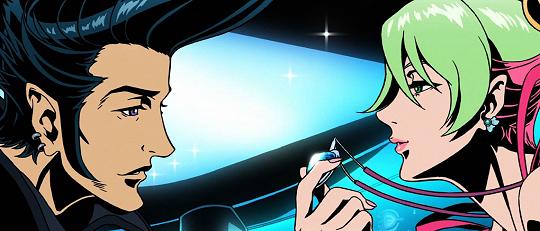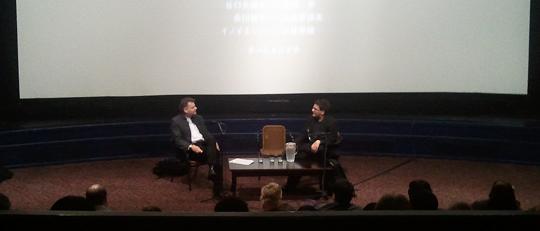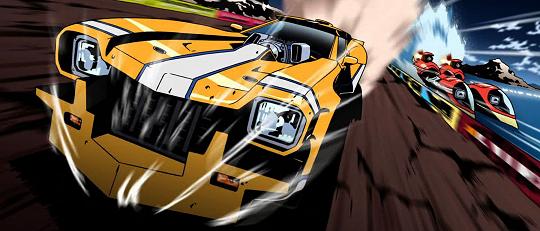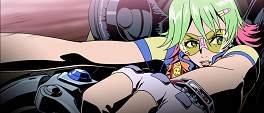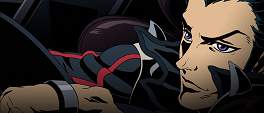Thanks to a peppering of festival showings and a word-of-mouth groundswell, Redline already has a great start to it. Although being in production for five years might cast doubt on that. Premiering fourteen months prior in Locarno, Switzerland and travelling around the festival circuit before getting its UK premiere earlier in May, the volume of veracity of opinion made this my most anticipated of the Glasgow Scotland Loves Animation events. Saying it didn't disappoint would be doing it an injustice.
Praise can of course be heaped on its visuals – director Takeshi Koike's previous works such as Dead Leaves and the Animatrix's World Record are comparatively poor primers for the stylistic barrage on display here – just as scorn can be heaped on its paper thin plot. But something gels the film together, making the dog faced aliens, the trance-house soundtrack and the outright craziness work. To paraphrase the subsequent question and answer session: they put everything into the movie, chewed up the scenery, then shot it with an orbital laser.
The influences of the film vary from the obscure to the obvious, with eighties staples such as Dangaioh, Devil Man, Speed Racer and Cutie Honey forming the vanguard of the latter, but it's only with knowledge of even earlier series that the full scale of the director's vision.
From an inebriated director to Jonathan Clements who eruditely relayed his notes to the waiting audience after the show, Redline is a re-envisioning of late seventies series, Machine Hayabusa (Machine Falcon / Hawk). Set in the near future and featuring a Japanese team that refused to cheat, unlike the Black Devil Team lead by the nefarious sounding Ahab Mobil Dick, it bears many a similarity to Redline, not least of which in the protagonist “Sweet” JP. Other influences were swiftly debunked, the common tagline attached to the film being “an adult Wacky Races” which was entirely ruled out. Just as Koike's visit to Texas and its proliferation of muscle cars wasn't cited as a key influence, although Jonathan speculated that the tax deductible nature of hiring a Trans Am or Shelby Cobra (ala Gunsmith Cats) for “artistic reference” may play a key part in many photo-realistic reproductions in anime.
This wide spread of influences and references carries over to the characters which is as if every anime franchise was part of one large universe and decided to have a race together. The deliberate bedlam and lack of coherent back story to racers that characterises Redline is mostly intentional and was likened to how a movie such as Cannonball Run appears to foreigners – a mish-mash of in-jokes and recycled characters and complete confusion to anyone not familiar with the individual actors. A similar tact taken by character designer Katsuhito Ishii, best known for OVA Trava (who he co-directed with Takeshi Koike) and numerous festival shorts and adverts, but who has spliced much of his back catalogue into Redline, just as other designers before him such as Kazuo Komatsubara of Captain Harlock fame, or the great Osamu Tezuka.
Anecdotally Jerome Mazandarani of Manga Entertainment wanted to obtain some of Ishii's festival shorts for the DVD release of Redline to give some context to the chaos, but the likelihood of that happening with the rights nightmare involved is slim.
The burning question for a production of such length though is always going to be: why did it take so long? Certainly the quality is evident in every frame of the film, but five years is an extraordinary amount of time. Though only speculation, one possibility is that when the production was started in 2004/5, the anime business environment was at its peak and the “dream of export” was alive an well. The expectation being that a lot more advance foreign money would materialise than in fact did, lengthening production and meaning more of it had be sourced closer to home. The short answer to this of course is that: whoever authoritatively knows, isn't telling.
With influences and production nuances covered, the discussion diverged slightly to put the film into the wider context of anime by first going all the way back to when science fiction was one of the first anime genres produced (Astro Boy et al) in 1963, proving popular with kids but not with adults. This situation lead to new genres being explored come 1965, specifically sports, which succeeded in though still being targeted for kids could be immediately understood by adults and also allowed for advertising a far greater range of products than sci-fi had allowed.
From that ethos came the quintessential baseball anime, Kyojin no Hoshi (Star of the Giants), directed by Tadao Nagahama and adapted from the manga of the same name. This anime was noteworthy in that it put forward many of the styles and tropes that came to characterise both the sports genre and anime in general. The most relevant to Redline being the supposedly infamous “Thirty minutes, one ball” episode which, as its title implies, spent an entire episode with only a single pitch. It needed to do this not for budgeting reasons but because the anime production had already caught up with the manga, and without the crutch of Naruto-esque filler to lean on, a collection of flash-backs, time distortion, static cuts and other tricks made up the episode.
With those directorial tricks in place, it took until the 1970's for producers to run out of sports to mine for anime and turned then to car races, making the sponsors rub their hands together with glee at the thought of being able to sell toys. It was these anime that Koike grew up with and made the most impact, subsequently defining his own approach to directing a feature such as Redline.
With time in the session beginning to wane, Jonathan mentioned some further anecdotes from the Locarno premiere, including how it was the director's honeymoon despite his wife not being fully informed of his true intentions, though being accompanied by half of Mad House studio likely tipped off his new wife. It was however time for audience questions which were slightly more adroit than the Trigun Badlands Rumble queries and kicked off with a question as to why use a Trans Am as the central car? The answer referenced the previously mentioned tax deductible nature of photographic references, Koike's visit to Texas as well as the obvious: he just liked that model.
The next question had to do with JP's status as the “rebel” of the movie with his flick-comb, coiffed hair-do and leather jacket. The answer was two-fold and started with the music used in the movie, specifically the signature track which it transpired had changed each time Jonathan had seen the movie, indicating tweaks were obviously being applied right up until launch. The speculation was that the type of music that was used in the feature – hard trance – was mostly due to music label Avex Trax involvement as a sponsor. This naturally lead on to licensed music such as Eden of the East's use of Oasis and how that inclusion can be a prime reason for not exporting, especially Japanese live action series which rarely see airtime outside of their native country.
Circling back to the idea of a rebel though, it fed into the classic idea of the establishment being the villain and the outcast or rebel being the saviour. Before the cinema attendants turfed both the panel and the audience from the cinema, there was just time to mention a study done in Durham, North Carolina regarding the average reading age of characters in media, finding that the antagonists generally have a reading age of two or more years above the protagonist.
With that, the Redline presentation was over, and I was left with trying to make sense of the visual and auditory assault I had just been the subject of. All I knew in the aftermath though was that I'd had a damn good time both now and across the weekend, and though I wouldn't attend the final feature of the Scotland Loves Animation Glasgow weekend, it was more than a fitting end.
